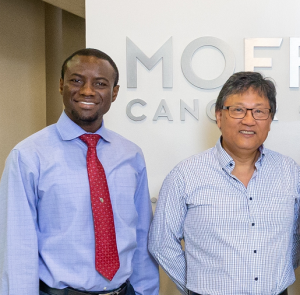Each year, almost 250,000 people in the United States are diagnosed with prostate cancer. Although the overwhelming majority will be successfully treated, some patients face a sobering statistic: Black men are more than twice as likely to die from prostate cancer than their white counterparts. The causes of this disparity are complex and involve both the biology of the disease and factors related to access to and delivery of health care.
 With V Foundation funding, Jong Park, Ph.D., and Kosj Yamoah, M.D., Ph.D., at H. Lee Moffitt Cancer Center and Research Institute are working to get to the root of this disparity by looking closely at the biology involved. So far, they have identified a group of genes that could lead to more personalized treatments for Black men. They also discovered new insights that could help improve screening methods to catch tumors earlier.
With V Foundation funding, Jong Park, Ph.D., and Kosj Yamoah, M.D., Ph.D., at H. Lee Moffitt Cancer Center and Research Institute are working to get to the root of this disparity by looking closely at the biology involved. So far, they have identified a group of genes that could lead to more personalized treatments for Black men. They also discovered new insights that could help improve screening methods to catch tumors earlier.
Delving into differences
To better understand how cancer in Black men differs from that in other groups, the researchers compared prostate cancer gene expression in several thousand tumor samples from African American and non-African American men.
They were particularly interested in studying tumors that lack a genomic alteration known as ETS fusion. ETS fusion shows up in around 60% of cases in white men and is used as an important biomarker to diagnose prostate cancer and determine the specific cancer subtype. This biomarker, however, isn’t as useful for Black men because their cancers lack ETS fusion 75% of the time.
“The gene expression studies revealed a group of genes in ETS fusion negative tumors that relate to cancer recurrence,” said Park. “Using these genes as biomarkers could help doctors predict who will have more aggressive cancer and help make sure that African American patients get the right treatments. This new information can also be used to develop a first-line treatment based on inhibitors for these genes.”
The analysis also revealed that Black patients may respond better to certain types of treatment, including immunotherapy and radiation therapy, which may be due to the biology of their disease. Additional studies have revealed immunologic differences that could be used to fine-tune immunotherapies to work better in this population.
Location matters
The researchers also discovered information that might help improve screening and diagnosis for prostate cancer across racial groups. They saw that ETS fusion negative tumors tend to be in the anterior (front) part of the prostate gland, rather than the more common posterior location. An anterior tumor might be more likely to be misdiagnosed or diagnosed later because biopsy needles tend to only reach the posterior part of the prostate gland.
“It was previously thought that African American men have more anterior tumors,” said Park. “However, we found that non-African American men with ETS negative tumors also tend to have anterior tumors, indicating that the anterior location is not race specific but is actually a biological phenomenon.”
The researchers are seeking funding for a pilot study that would examine whether mobile MRI technology could be used to better diagnose prostate cancer in Black men. Mobile MRIs can reveal otherwise hidden tumors with a quick 15-minute, contrast-free test that can be deployed in the community.
“In addition to finding prostate tumors, no matter the location, this technology could remove the barrier of having to come to a hospital for a scan,” said Yamoah. “When used in combination with blood tests, we think this approach might allow a more targeted way to diagnose prostate cancer in men of African origin.”
Getting the data
The researchers say that the V Foundation funding allowed them to gather preliminary data that wouldn’t have been possible otherwise. This has led to a variety of new collaborations and grants that are expanding on their findings.
Park adds that a multidisciplinary approach has been key for examining this complex health disparity. “I consider our team to be a dream team,” he said. “It includes physicians, a pathologist, epidemiologists, bioinformatic scientists, biostatisticians and a variety of other experts. Together we have generated a great deal of new data and have also formed new collaborations with other teams.”




